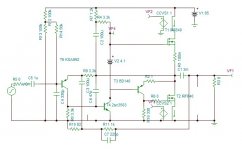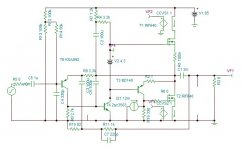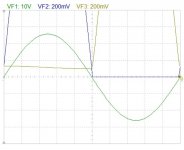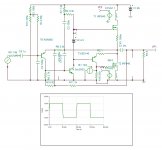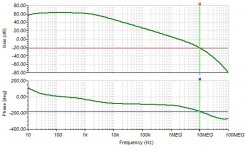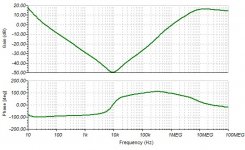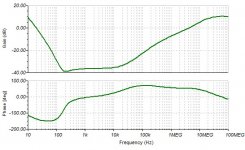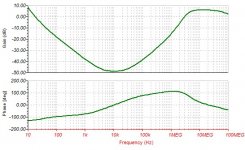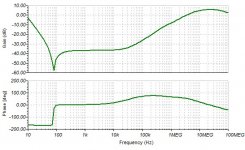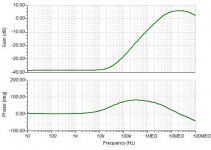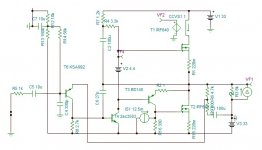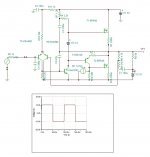I wonder if there is something wrong or a miracle going on in this circuit. I forgot to check the bias with these new mosfets. There is only 200ua bias the bd is cut off but there is no any crossover distortion. On the contrary , when I apply some bias of 15ma, the distortion increases!
There is only 200ua bias - current through R8?
Mind to have a close look at the DC voltage divider at the input? The upper leg's resistance is 490k, while the lower leg is only 100k - about one fifth of the upper one. To obtain symmetry in the output stage, I'd expect both values to be almost equal. Am I right in my assumption that the 2N5401 (or KSA992) draws significant base current to pull it's base up to about ½ the supply voltage? How does the amplifier behave with 2N5401 of different hfe? And how does this amplifier behave with different supply voltages?
Best regards!
Best regards!
You must post this question on APEX's retro amp thread. There is lot of voltage drop across 12k dc feedback.
By curiosity, I tried the base-collector 47p on the input transistor along 1.8k resistor on the input. The distortion at 10khz doubled. I wonder what is it for.
By curiosity, I tried the base-collector 47p on the input transistor along 1.8k resistor on the input. The distortion at 10khz doubled. I wonder what is it for.
Last edited:
To quote the AX6 thread. the 12k feedback resistor is DC, to move the center point of the amp to 1/2 the upper rail voltage. The 6.8k resistor from the outside of the speaker capacitor is the AC feedback path.
In precedent circuit T2 was operating in class C. By biasing with a ccs to 120ma and keeping the BD cut off, now it is the T2 remains non switched. The distortion now keeps 0.00x all the range of powers. At very low levels, it is SE class A.
Hayk
Attachments
Last edited:
Need a temperature compensated bias circuit 🙂
I wonder how it will be with darlington npn.
I wonder how it will be with darlington npn.
Last edited:
Needs 2 temperature compensation bias. The 4.4 bias voltage is adjusted to have the driver transistor just at cut off, whereas the 12-13 ma needs to decrease with temperature , an Lm334 in parallel to 330 ohm can do. I am trying out different bias currents as it limits the SE class A limit. 200-300ma looks most adequate . What I appreciate most now, the distortion 1khz and 10khz are nearly the same. The open loop BW is 100khz.
Hayk
Hayk
output impedance
The output impedance of Dual, is not suitable for modern bass reflex speakers, Apex solution is much better.

Dual
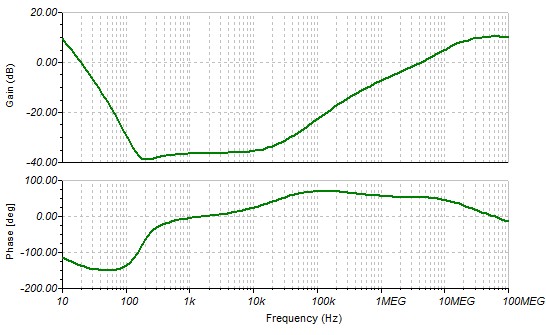
apex

dual3886

Look how apex impedance becomes negative bellow 100 hz .
3886 apexway
The output impedance of Dual, is not suitable for modern bass reflex speakers, Apex solution is much better.
Dual
apex
dual3886
Look how apex impedance becomes negative bellow 100 hz .
3886 apexway
Attachments
Last edited:
split supply version

impedance

impedance
Attachments
Last edited:
split supply version
Burn those speakers, good ones only cost 8 times what the amp does.
Or install a competent protection circuit, having 2/3 as many parts as the amp has and a $40 relay that might actually work, instead of those $2 toys everybody uses with only an AC current contact rating.
Burn those speakers, good ones only cost 8 times what the amp does.
Or install a competent protection circuit, having 2/3 as many parts as the amp has and a $40 relay that might actually work, instead of those $2 toys everybody uses with only an AC current contact rating.
Last edited:
What's wrong with a conventional quasi-complementary output stage on a transistor of the same type?On a MOSFET or conventional transistor
Hai Maxim. This type of output circuit is inspired from LM3889 output which doesn't have any crossover distortion or negligible. The quality is not of course equivalent to class A but it is superior to ordinary complimentary class AB.
Hayk
Hayk
I'm sure it doesn't make much sense to introduce crutches in discrete circuits. Unless the design of the case and radiators does not allow the use of modern transistors
- Home
- Amplifiers
- Solid State
- Semi Non-Switching Output Stage of LM3886 Clone
